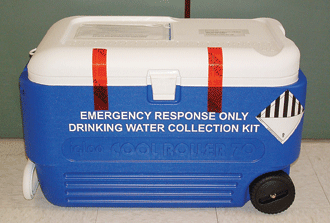Wisconsin Emergency Response
Drinking Water Collection Kit Information

Purpose of the Wisconsin Emergency Response Drinking Water Collection Kit
- Use for emergency drinking water sampling events only
- Use after a “credible” threat has been determined by local partners
- Collect water to test for “unknown” biological, chemical and radiological agents
- Designed to be simple and safe to use by sample collectors who may include water utility operators, staff from local health departments or state agencies, regional HazMat teams, or the Wisconsin Civil Support Team
- Provides quality data
- Requires little work to maintain
Wisconsin Emergency Response Drinking Water Collection Kit Contents
- Water collection instructions
- Limited personal protective equipment
- Containers for biological, chemical and radiological water analysis
- Sample submittal/chain of custody form
- Markers and pens
- Evidence tape
Wisconsin Emergency Response Drinking Water Collection Kit Locations
- 206 kits located throughout the state
- Locations include the water utilities of the county seats and/or water utilities serving more than 3,300 people, tribal offices, some local health departments and offices of the Wisconsin Rural Water Association
- Locations also include regional offices of the Wisconsin Department of Natural Resources (WDNR), Wisconsin Emergency Management (WEM), and Wisconsin Department of Health Services (WDHS); and the 54th Civil Support Team
Prepared by the Wisconsin State Laboratory of Hygiene (WSLH) in collaboration with the following partners:
- Wisconsin Department of Natural Resources, Wisconsin Department of Health Services, Wisconsin Emergency Management, State Crime Laboratory, University of Wisconsin-Madison Veterinary Diagnostic Laboratory and Wisconsin Department of Agriculture, Trade and Consumer Protection
- Milwaukee Water Utility, City of Milwaukee Health Department, the Wisconsin Rural Water Association and regional HazMat teams
Emergency Response Drinking Water Collection Kit Locations

Drinking Water Contamination Emergency Response Guide
The Drinking Water Contamination Emergency Response Guide flowchart has space to record the location of the nearest emergency drinking water collection kit and contact information for local agencies that will assist in a response to intentional contamination.
These fields should be completed by the water utility operator. The Department of Natural Resources asks that the guide be included in the water utility’s emergency response plan or other appropriate location.
In the event of an intentional drinking water contamination event at a water utility the steps below should be followed:
- Work with local agencies and first responders to determine if the threat is possible
- Implement any immediate operational responses
- In conjunction with state and local agencies, determine whether sampling and sample analysis is needed
- Obtain an emergency drinking water collection kit from the nearest storage location
- Given the hazards apparent in the given situation, determine who will sample the water
- Follow the instructions included in the kit for filling the bottles
- Deliver the kit to the Wisconsin State Laboratory of Hygiene in Madison
- Results of the analysis will go to the Department of Natural Resources, Department of Health Services, and the community’s Health Officer
- Determine and implement further public health response actions, and
- Recover and return the water system to normal operation.

If you have any questions about kit location contact information, emergency sampling and analysis process, please contact:
- Steve Elmore (WDNR), 608-264-9246; steve.elmore@wisconsin.gov
- Noel Stanton (WSLH), 608-224-6251; noel.stanton@slh.wisc.edu
- Meshel Lange (WSLH), 608-224-6273; meshel.lange@slh.wisc.edu